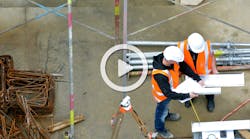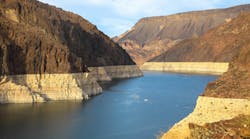Willmets was working as the project manager for the city of Ontario, Canada, water utility about six years ago. At the time, he was overseeing a pipe relining project for an entire community on the outskirts of the city. It wasn’t a small project, boasting a budget of about $3 million. And relying on traditional dig-and-replace methods, it could have disrupted traffic and annoyed homeowners for weeks.
But the Ontario water district chose a different route. To complete the project, the Ontario water utility relied on trenchless technology, sending remote-controlled robots down the pipes to bore out the service lines and reline them. This meant no digging and no inconvenience for area residents.
One homeowner, though, was curious about the water utility truck parked outside her home. She never saw crew members digging into the ground. In fact, whenever she peeked into the truck, she saw what looked like city employees playing video games.
This didn’t sit well. So the homeowner called the city to complain. It was Willmets’ task to explain to the homeowner exactly what was going on.
“I told her, we could have a backhoe and shovel going the entire time or we could solve the problem in this far more low-key and less intrusive way,” says Willmets. “Once she understood what we were doing, she was thrilled. Homeowners really don’t like to have the street outside their homes torn up for weeks on end. The noise, the dust and the inconvenience really bothers them.”
In fact, the homeowner was so impressed, and such a new fan of trenchless technology, that she brought the Ontario utility workers holed up in that van multiple plates of homemade cookies to show her appreciation.
Ontario, of course, is far from the only municipality relying on new forms of technology to complete pipe retrofitting and relining projects. A growing number of utilities are turning to trenchless technology and new pipe products to speed the relining and retrofitting process and reduce the disruption such projects bring to residential homeowners and businesses.
The goal is to get construction trucks and workers off the streets as quickly as possible. This might not always result in homemade cookies, but it often does bring about good press.
And that is just one reason, albeit an important one, to expect utilities across the country to continue reaching for new technologies that make their retrofitting and relining projects less stressful ones.
“Part of what we are trying to do here is to make municipalities and utilities aware of the other techniques that they can use on their big pipe projects,” says Willmets, who has since retired from the city of Ontario and now serves as executive director of the Liverpool, NY-based North American Society for Trenchless Technology.
“The big buzzwords out there are “˜green’ and “˜green technology.’ Trenchless methods have been around for several years, and we like to think that we have always been green.”
The good news for water utilities is that there are plenty of options–not just trenchless but new pipe technologies, too–that can help them complete even major pipe projects with less disruption to city residents and business owners.
The key remains education: The better educated utilities are about these technologies the more likely they are to embrace them.
Choosing the Right Pipe
Tight budgets mean that municipalities and their water utilities must look at every option possible to save money. For pipe projects, that often includes the type of pipe that municipalities install in their water systems.
Tony Radoszewski, for instance, points to the benefits that plastic pipes bring to utilities. Of course, this isn’t surprising; Radoszewski is executive director of the Irving, TX-based Plastics Pipe Institute.
Radoszewski cites two main ways in which plastic pipe can save utilities money in both the short and long term.
In the long-term, plastic pipe often requires less maintenance and repairs than do traditional pipes. That’s because plastic pipe is resistant to the rust that metal pipes sometimes suffer. And when pipes don’t rust, municipal workers have to spend less time unclogging them. Water utilities also don’t have to worry about overworking their pumps, something that can happen when pipes rust so thoroughly that pumps have to work overtime to push drinking water through them.
“In the grandest scheme of things, you don’t have the issue of rusting-out pipes that you sometimes have to contend with when you’re using other pipes,” says Radoszewski. “Plastic pipes don’t rust. You don’t have that issue of corrosion. In metal pipes, there’s a buildup that can occur that results from the dissolving of salt in iron form. It’s like clogging your arteries. It restricts the flow of water through the pipes.”
Radoszewski remembers one study conducted by the Plastics Pipe Institute of water-delivery systems in Miami, FL. They found that in some pipes, the space water could travel through had shrunk down to the size of a pencil.
“That affects water delivery and taste,” he says.
It also can turn water brown when homeowners switch on their faucets after leaving town for the weekend. Needless to say, this does little to inspire confidence among homeowners in their local water utility.
In the short-term, municipalities can save money by relying on a polyethylene pipe system in which the ends of pipe sections are welded together. These welded ends replace the ball-and-spigot joint construction of metal pipes. It also leaves utilities with monolithic pipe strings.
Because of this, there is no opportunity for pipes to come apart as a result of shifting soil. The welded-end system helps prevent water leaks, leaks that can result in costly water loss for municipalities. Again, at a time in which budgets are tight, any technology that prevents water loss should be welcomed by utilities, Radoszewski says.
“It can be a completely leak-free system,” he says. “You’re not dealing with two sticks of pipes joined together. This provides municipalities with a leak-free opportunity.”
“Educating municipalities is part of our challenge,” says Radoszewski, who believes in explaining the benefits and drawbacks of various pipe materials to water purveyors.
“When we talk to municipalities about polyethylene pipe, many of the mayors will react as if plastic is plastic. We have to do more education with them so that they understand the features and benefits inherent in these two different types of plastics.”
The “green” movement is helping in this task, Radoszewski says. Municipalities today are focusing more efforts on conserving their limited water resources. This favors polyethylene pipe, he believes, because the welded-end setup, greatly reduces the amount of leakage in utility systems.
“Less water loss equals a greener system,” he says.
Surprisingly, the weak national economy is also helping the Plastics Pipe Institute promote polyethylene pipe. According to Radoszewski, the combination of this type of pipe and trenchless installation enables municipalities to save significant dollars when relining or retrofitting their water system’s pipes.
The key, he states, is for municipalities to be willing to look at alternatives to the relining and retrofitting procedures upon which they’ve long relied.
Radoszewski points to the city of Houston, which is replacing a crumbling prestressed concrete cylinder pipe with a polyethylene pipe. Even though the pipe being replaced stretches for less than 2,000 feet, the city will save $2 million to $4 million by replacing it with polyethylene pipe.
He also cites Miami-Dade County, which recently replaced a 72-inch concrete sewer line. The project was originally expected to cost $15 million for a traditional dig-and-replace project. Instead, the county decided to replace the pipe with a polyethylene pipe. The county also turned to trenchless technology. The result? The project only cost the county $4.9 million.
“That’s a savings of $10 million,” says Radoszewski. “Because municipalities are traditionally not comfortable with change, they often do what they have always done instead of looking at alternatives. Because of this, they also fail to enjoy the financial rewards that come with looking at new technologies.”
Alternatives to Plastic
Every pipe project is different. And for some projects, plastic pipe simply won’t do.
That’s where manufacturers such as Northwest Pipe Company come in. Based in Vancouver, WA, Northwest Pipe manufactures large-diameter high-pressure welded steel pipe and bar-wrapped concrete cylinder pipe.
In addition to its full lengths of pipe, Northwest Pipe Company manufactures collapsed cylinder pipelines. These pipelines arrive to sites split in half longitudinally and collapsed inside of themselves. They are then fit into a host pipe, expanded out and welded into place.
This latter method of retrofitting or relining pipes comes with a big advantage: an increased ability to reline pipes without digging into the ground, even when municipalities have to tackle pipe projects plagued with bends and curves.
“You can get around the minor bends or curves with this product,” says Greg Smith, western regional engineer with Northwest Pipe. “When the collapsed cylinder pipelines reach their final resting places, you can expand them so that the space between the host pipes and the replacement cylinders is so small that you don’t lose a lot of capacity.”
For the right site and the right project, these collapsed cylinder pipelines can save municipalities a significant amount of money. That’s because they can help eliminate the need for digging deep trenches to repair leaking or aged pipes.
Smith says that this technology is perfect for those sites in which digging new trenches is not only expensive, but also inconvenient. For instance, it might not be feasible to dig under a busy strip center. Doing so would hurt the businesses in the center that rely on traffic. Workers would also be at risk as they dig in high-traffic areas.
With the collapsed cylinder product offered by Northwest Pipe, workers only have to open a single portal to gain access to the damaged or leaking pipe. Once they have this access, they can stretch replacement pipe into the damaged pipe for longer stretches.
Northwest Pipe has seen demand for its pipe increase as municipalities scramble to repair their aging water system infrastructures. Smith says that his company is especially busy replacing pre-stressed concrete cylinder pipes.
“Those kind of pipes are failing at a pretty high rate today,” says Smith. “It appears to be failing due to the breaking of the stress-reinforcing wires around the pipe. As those wires break, the pipeline can take less pressure. And when these pipes fail, they fail catastrophically. Other pipe materials, they develop leaks and get repaired. The pre-stressed concrete cylinder pipes don’t work that way. The collateral damage that can result from their failure can be significant.”
Pipe Bursting and Sliplining
Pipe bursting and sliplining are two other technologies that help water utilities avoid the mess, cost and disruption of the traditional dig-and-replace process.
Poway, CA-based Underground Solutions manufactures PVC pipe that is used in both processes. With pipe bursting, Underground Solutions’ PVC pipe is attached to the back of a device called an expander head. Using either hydraulic or pneumatic power, work crews send the expander head through damaged pipeline. This head breaks the damaged pipe into small pieces and pushes it into the surrounding soil. The PVC pipe attached to this expander then replaces the old pipeline immediately.
During the sliplining process, workers push Underground Solutions’ PVC pipe inside a larger, but damaged, host pipe, a solution that can quickly and effectively eliminate leaks.
Both methods are favorites of municipalities looking for trenchless ways to repair aging or damaged water pipes, said John “Bo” Botteicher, senior product engineer with Underground Solutions.
But Underground Solutions’ pipe does offer a unique benefit: Its PVC pipe boasts a joining technology in which separate pipes are thermally fused together.
“In essence, it’s a monolithic length of PVC pipe,” says Botteicher.
That’s why it’s so useful, he says, especially “when it comes to projects in which you are looking to pull the product into place. Pipe bursting and sliplining are perfect applications for a whole pipe.”
At the same time, Underground Solutions’ PVC pipe is made of a material familiar to utility workers. This, Botteicher says, is another advantage.
“Because it is PVC, a material that is accepted and used extensively, workers need no special training or knowledge to work with it. Municipalities need no special knowledge to maintain the product after it is installed. They can use standard water works fittings. They do not have to make a big investment in equipment, parts or skill on the part of the folks who work with the system.”
Botteicher says that PVC pipe works well–especially when it’s thermally fused together–with trenchless pipe-restoration methods.
And that, he says, is important as utilities become ever more focused on reducing the frustration that they cause their commercial and residential customers.
“People are taking longer looks at trenchless installation for the benefits it has in terms of the sociopolitical costs involved with traditional construction,” says Botteicher. “There is so much disruption with traditional construction. If utilities can avoid that, they will place less stress on their municipalities. Also, there are projects that simply could not have been completed if not for this alternate method of installation.”
Botteicher points to busy highways or obstacles such as rivers. With trenchless technology, water utility crews won’t have to dig into such difficult terrain.
“You don’t want to have to open up and dig into some sites,” he says. “Maybe you can’t even do it. This technology allows you to install a pipe that you might not have been able to install before.”
The New Focus on Trenchless
Of course, as with all decisions, money plays a key factor in the trend toward trenchless pipe projects. The simple truth is that trenchless work costs less money. And, as Botteicher says, it leaves water utilities with an end product that has as good or better design life than does dig-and-replace or traditional design methods.
“It’s always “˜Show me the money’ in the end,” says Botteicher. “You can talk about pedestrians not being affected by big construction projects, and that is important. But if you can save money in the end, then you really have something.”
Botteicher says that the best evidence that trenchless is here to stay can be found when examining the bid specifications that municipalities are laying out for their pipe rehabilitation or relining projects.
A growing number of these specifications are calling only for trenchless technology, Botteicher says. In the past, project specifications would allow contractors to bid with either dig-and-replace or trenchless methods such as slipline and pipe burst.
Those days, though, appear to be waning, Botteicher says.
“You are starting to see so many more projects specifically designed for trenchless and trenchless only,” he says. “People are focusing on the benefits of trenchless. That’s the big difference that I’ve seen in the last five years or so.”
Trenchless technology, though, does have its limits. This is a fact supported by none other than Willmets, the executive director of the North American Society for Trenchless Technology.
Willmets says that while trenchless methods can save utilities both money and disruption, they aren’t a good fit for all pipe repair projects.
As an example, Willmets points to a road in which all the pipes are leaking or damaged. In such a case, a full reconstruction–which would necessitate dig-and-replace–might be the best option.
However, in a situation in which only a small number of pipes are bad, trenchless might be the wiser choice, Willmets says.
The key is for water utilities to do their homework before committing to trenchless methods.
“The last thing you want to do is to promise that you are going to fix a water system with a new process and then see it fail,” says Willmets. “You want your foray into trenchless to be a good news story. Trenchless can be an enormous good news story. Crews can be in and out of the streets in nine or 10 days.
“Sometimes, people will be upset when their pipes are repaired with the dig-and-replace method,” he continues. “They want to know why they did not receive the same treatment as other streets in which trenchless was used. Utilities have to explain that trenchless, when appropriate, is a terrific option, but that it does not always work for every situation.”
But when it does work? The trenchless approach can engender goodwill on the part of a community,
“You might be considering a job in a high-traffic area. In such cases, the sheer impact of reconstructing an entire roadway can be crippling to the local economy,” says Willmets. “It can be very damaging to businesses. You can choke your traffic flow down to a trickle. If you do it with the trenchless approach, you are obviously serving your public much, much better. Again, it comes back to matching the technology to the actual situation.”


